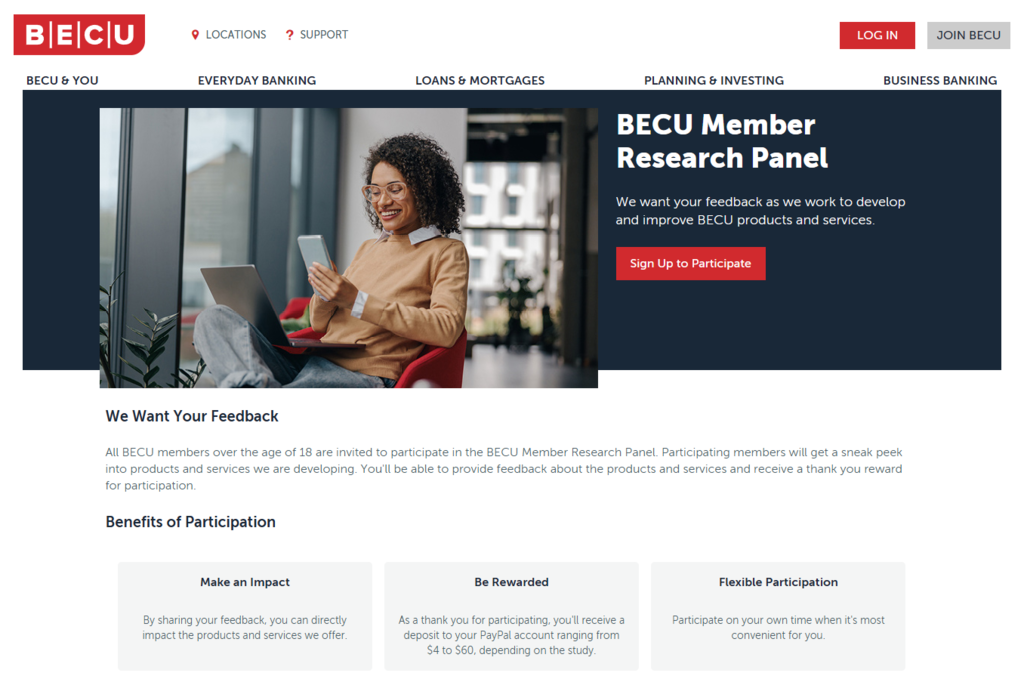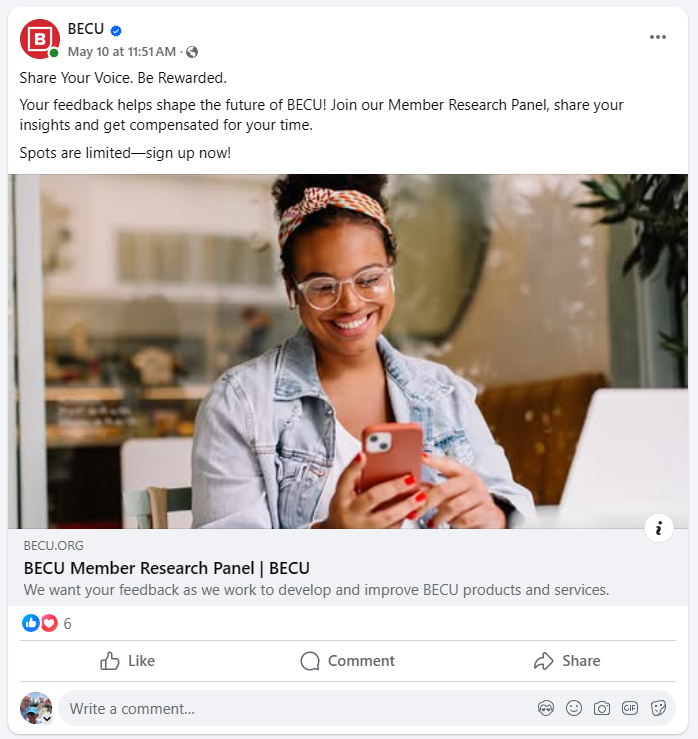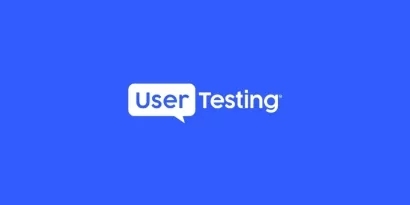
Episode 171 | May 19, 2025
Building a customer research panel with BECU
Learn how BECU built a high-impact member research panel with UX leader Jessica Schultz. Tips on engagement, recruitment, and scaling insights.
How BECU built a thriving customer research panel to scale UX insights
In a recent episode of the Insights Unlocked podcast, Jessica Schultz, senior manager of experience research at BECU, shared the behind-the-scenes journey of launching a successful customer research panel. Jessica talked with Becky Wright, UserTesting’s senior staff product researcher and who helped build UserTesting’s custom panel.
From gaining internal buy-in to keeping participants engaged over time, her insights offer a playbook for UX research teams looking to operationalize feedback loops and bring the voice of the customer to the forefront.
With more than 1.5 million members and $29.4 billion in assets, BECU is the largest not-for-profit credit union in Washington state and one of the top four financial cooperatives in the US.
Let’s dive into how BECU built their panel, what worked, what didn’t, and what others can learn from their experience.
Why BECU built a member research panel
BECU has long prioritized member experience. But traditional research recruitment methods weren’t cutting it—especially when they needed fast, actionable feedback from real users.
“We realized we could take recruiting from two to three weeks down to two to three hours by investing in a member panel,” Jessica said.
By building a custom customer research panel, the BECU team created a direct line to their diverse membership base. This allowed them to quickly source participants for usability testing, moderated interviews, and unmoderated studies—all without the delays of third-party recruitment.
ON-DEMAND WEBINAR
From friction to conversion: optimizing digital bank account opening with customer insights
Mapping the journey to panel launch
Launching a member panel is no small feat, especially in a highly regulated industry like banking. The BECU team approached it like a full-scale project, complete with Kanban boards, journey maps, and extensive internal coordination.
“We ran it like a full project,” Jessica said. “It took about six months to get it built, tested, and launched.”
She emphasized the importance of cross-functional collaboration, especially with legal, security, and marketing teams. To gain internal trust, her team created journey maps detailing every step—from invitation to onboarding to feedback collection—so stakeholders knew exactly what members would experience.
Key steps in their launch process included:
- Understanding the full member journey, including data privacy touchpoints
- Creating clear documentation for internal approvals
- Running competitive analysis on other research panel programs
- Designing and testing a public-facing landing page
- Crafting a demographic-rich onboarding survey to support smart filtering
Scaling user feedback through better research operations
Once the infrastructure was in place, BECU had to focus on driving engagement and making the experience easy and enjoyable for participants. One of their biggest wins came from improving the clarity of their study instructions.
“Changing the way we write our protocols—being more specific—actually improved the output of all our studies,” Jessica noted.
By coaching panel members on how to participate in unmoderated tests, especially around “thinking aloud” on camera, they saw stronger responses and richer insights. Clear instructions also helped first-time testers feel more comfortable, which led to higher quality feedback.

How BECU keeps its customer research panel engaged
It’s one thing to build a panel—it’s another to keep it active. BECU employs several strategies to maintain participant engagement and prevent panel fatigue.
Engagement strategies include:
- Launching studies consistently so members have regular opportunities to participate
- Coaching participants who may need support in expressing their thoughts
- Highlighting member impact through a spotlight section on BECU’s website
- Promoting the panel via newsletters, social media, and customer service channels
- Including a general-purpose study that anyone can take right after signing up
“We want members to feel seen, heard, and safe while sharing their feedback,” Jessica said.
The team also tracks how many studies each panelist has taken, how fast studies fill, and how well the panel reflects BECU’s overall member base in terms of demographics, income, and digital behaviors.

The role of the member panel in UX research strategy
At BECU, the member panel isn’t just a tool for collecting user feedback—it’s a foundational part of the organization’s UX research strategy. The panel is used for both generative and evaluative studies, and it allows product owners to observe real users interacting with digital banking tools.
“We have a policy: every study starts with the member panel. Then we fill in with general population prospects if needed,” she said.
This ensures that feedback is always grounded in the lived experiences of actual users—particularly important for usability testing and changes to everyday tools like online banking and mobile apps.
And it’s not just the UX team using the insights. Product managers, designers, and engineers all benefit from seeing how real customers use their products, which helps with prioritization and roadmap planning.
Overcoming concerns about speed and adoption
Initially, there was some concern that switching from UserTesting’s global network to a custom panel might slow things down. But early wins helped shift the narrative.
Jessica recalled one moment when the panel allowed the team to schedule moderated interviews within 24 hours—something previously impossible with their old methods.
They also alleviated concerns by running studies in parallel: one with the member panel and one with general contributors. This allowed for faster synthesis and cross-comparison of results, helping stakeholders understand the added value of getting input from existing members.
GUIDE
The executive's guide to empathy-driven ROI
Measuring success and improving over time
To evaluate the health and effectiveness of their customer research panel, BECU tracks several key metrics:
- Total number of members signed up
- Number of active panel participants
- Study fill rates and turnaround time
- Demographic representation and balance
- Panel growth after marketing pushes
These metrics are reviewed quarterly, especially after major recruitment campaigns. The team also uses them to advocate for additional resources and report success back to the organization.
Advice for teams building their own research panels
Jessica offered some clear advice for any team looking to create a custom UX research panel:
Must-do’s:
- Document everything and map the full participant journey
- Align early with legal, security, and marketing teams
- Create demographic filters up front to reduce disqualification rates
- Design for transparency and participant trust
- Launch with at least one general study to onboard new members
Avoid:
- Sending too many study invites without qualification filters
- Launching niche studies before building a robust panel size
- Delaying participant engagement after sign-up
“If someone clicks on a study link and gets disqualified too many times, they’ll stop engaging” Jessica said. “So do the work up front to make that experience positive.”
The impact of a member-first research mindset
BECU’s success shows what’s possible when organizations put their customers—and their feedback—at the center of innovation. By investing in a dedicated UX research panel, they’ve created a more agile, empathetic, and member-driven organization.
Jessica’s closing advice?
“If you’re thinking about starting a panel, be clear, be consistent, and most importantly—make it easy for people to share their voices,” she said.
Resources and links:
- Connect with Jessica Schultz on LinkedIn
- BECU
- BECU's member research panel
- Connect with Becky Wright on LinkedIn
- Leverage your own customer panels with UserTesting’s Custom Network: This blog post discusses how organizations can create and utilize their own customer panels within the UserTesting platform, offering insights into recruitment, management, and engagement strategies.
- How to choose the right participants for your UX research: This article provides guidance on selecting appropriate participants for UX research, emphasizing the importance of demographic representation and participant engagement—key aspects of maintaining a successful research panel.










